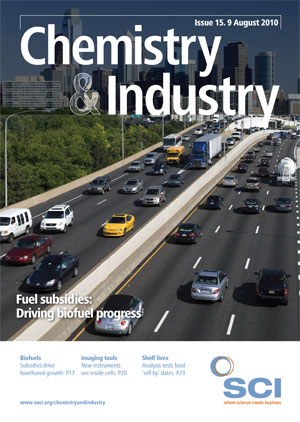Pharmaceutical majors in Europe and the US have seen their sales growth fall back in the first half of 2010, with a spread of sales growth that ranges from above the global market average of 6-7% through unchanged from H1 2009 to negative growth. One reason is that the majors are now facing the realities of diminished research pipelines, as well as competition from generics and also emerging markets. US health care reform has also begun to impact the sector’s financial results. One response has been to look for potential biotech takeover targets to provide a boost to flagging sales of previous ‘blockbuster’ treatments.
In the UK, GlaxoSmithKline (GSK) saw its Q2 2010 turnover level at £7bn, with pharmaceutical turnover level at $5.8bn and consumer healthcare up 3% to reach £1.25bn. Progress in GSK’s diversification strategy offset a13% decline in US sales. The US decline was attributed to lower Avandia sales, generic competition for the herpes medication Valtrex, the temporary suspension from the market of gastroenteritis vaccine Rotarix and some volatility in other vaccine shipments. H1 2010 sales were 7% up at £14.4bn, due primarily to pandemic products, without which H1 sales grew by just 1%.
AstraZeneca’s Q2 sales grew by just 1% to $8.2bn, at constant exchange rates, despite a 5% revenue growth outside the US due mainly to a 16% increase in emerging markets. Core Q2 operating profit was unchanged at $3.6bn at constant exchange rates. For H1 2010, revenue was up 4% at $16.8bn, and core operating profit was up 5% at $7.5bn.
In Germany, Merck’s Q2 revenues increased 16% to a record €2.2bn, including a record €284m contribution from liquid crystals that grew 50%. Pharmaceutical Q2 sales rose 9.9% to €1.6bn. Q2 operating income rose 76.8% to €326m. For H1, the total sales increase was 14.3% to €4.3bn, with pharmaceuticals rising 8.2% to €3.1bn, while the operating income was €621m, up 62.3%.
Switzerland’s Roche saw its H1 2010 sales rise 3% to CHF24.6bn, however, its operating profit rose 10% to reach CHF8.8bn. This profit rise was attributed to both sales growth and productivity improvements. Net income rose 37% to CHF5.6bn, compared with H1 2009, due to lower exceptional expenses relating to the integration of the acquisition of biotech concern Genentech.
Meanwhile, Novartis saw its Q2 net sales increase by 11% to reach $11.7bn, while its H1 sales rose 18% to $23.8bn. Operating income rose 25% in Q2 to just under $3bn, while the H1 increase was 37% to reach $6.5bn. The increases are attributed to a ‘rejuvenation’ of the company’s product portfolio, with recently launched products accounting for 21% of total Q2 sales, worth $2.4bn. In H1 2010, recently launched products accounted for 23% of net sales, or $5.5bn.
France’s sanofi-aventis saw its Q2 sales rise 4.6%, but fall 1.2% at constant exchange rates, to €7.8bn, while for H1, the increase was 4.3%, or 2.2% at constant exchange rates, to reach €15.2bn. Sanofi-aventis appears to be the front-runner to take over US biotech concern Genzyme as C&I goes to press.
Genzyme’s Q2 revenue fell from $1.2bn in 2009 to $1.1bn in 2010, due to supply problems with its injectable imiglucerase Cerezyme and agalsidase beta Fabrazyme. The company expects to be able to increase shipments of these products in H2 2010. Revenues in H1 2010 were $2.2bn, down from $2.4bn in H1 2009.
Also in the US, Bristol-Myers Squibb reported a 2% increase in net Q2 sales to reach $4.8bn, compared with H1 2009, with the impact of health care reform having a negative 1.5% on sales. Despite this effect, US sales rose 4% to $3.1bn while international sales fell back 2%, or 3% excluding currency exchange effects, to $1.7bn. Net H1 sales were up by 6% at just under $9bn.
At Eli Lilly, total Q2 revenue rose 9% to $5.7bn, driven by higher volumes. This growth was maintained across the whole of H1 2010, with total revenue increasing to $11.2bn. Total US revenue increased 8% to $3.3bn, due to higher prices and, to a lesser extent, increase volumes, while outside the US, revenues rose 9% to $2.5bn, due to increase demand and, to a lesser extent, favourable exchange rates outside the Eurozone, partially offset by lower prices. Q2 operating income rose 18% to $1.8bn, due to revenue growing at a faster rate than the cost of sales and operating expenses.





